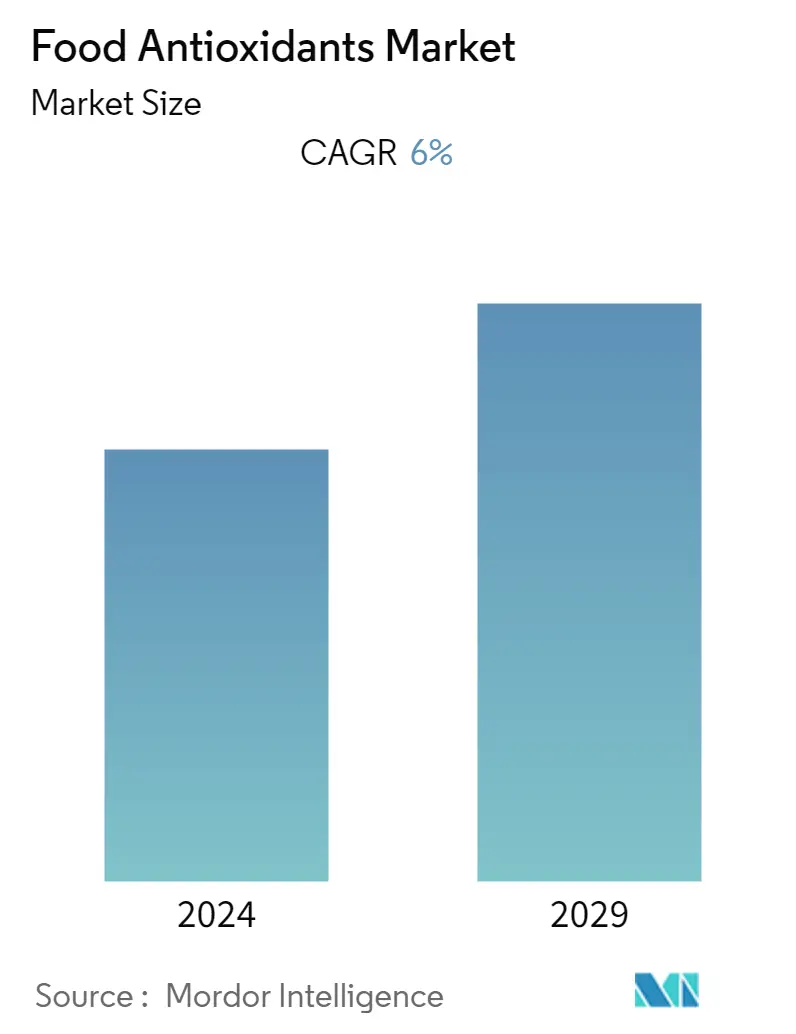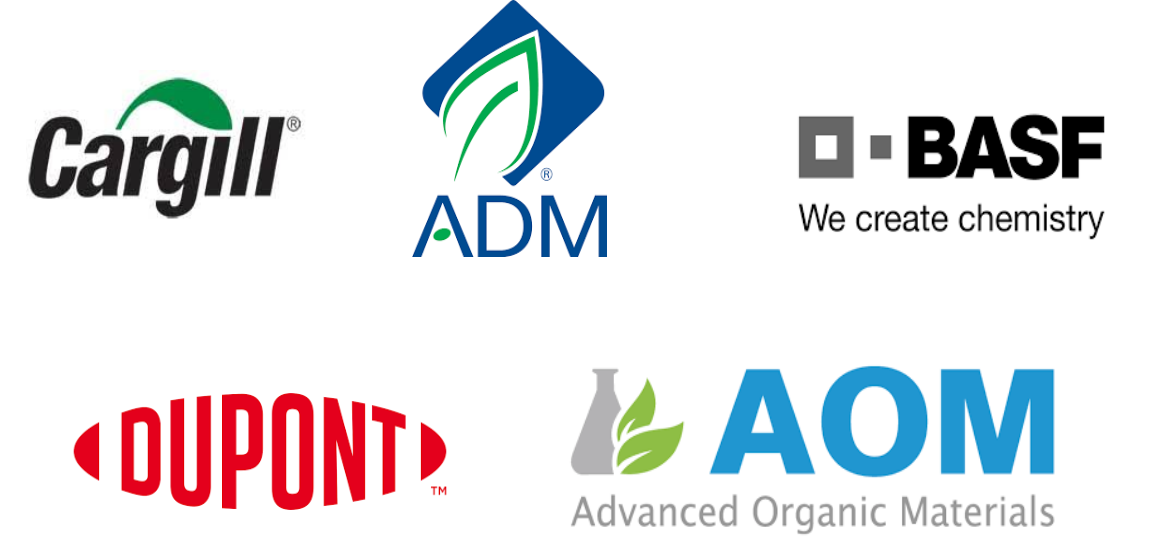Market Size of Food Antioxidants Industry

| Study Period | 2019 - 2029 |
| Base Year For Estimation | 2023 |
| CAGR | 6.00 % |
| Fastest Growing Market | Europe |
| Largest Market | Asia Pacific |
| Market Concentration | High |
Major Players
*Disclaimer: Major Players sorted in no particular order |
Food Antioxidants Market Analysis
Global food antioxidants market is growing at a CAGR of 6.0% during the forecast period (2019-2024).
- The growth of the market is attributed to the increasing demand and consumption of processed food, where food antioxidants are highly used, and it also improves the shelf life of products such as bakery, confectionery, and snack products. The presence of antioxidants effectively inhibit oxidation and extend the shelf-life of food products. Additionally, research and development in this field and surveys conducted by the research institutes have fueled the growth of the segment. For instance, The American Heart Association recommends a diet high in fruits, vegetables, and other foods that contain antioxidants to help fight cardiovascular disease. Also, the US Agricultural Research Service suggested that a diet high in antioxidants, especially those found in blueberries, strawberries, and spinach, may also help fight the loss of brain function associated with aging.
- Synthetic antioxidants such as butylated hydroxyanisole (BHA), butylated hydroxytoluene (BHT), propyl gallate (PG) and tert-butylhydroquinone (TBHQ) dominate the market since decades, however, the shift of the consumers mindset towards health consciousness and clean-labeled foods with all-natural ingredients, natural antioxidants segment are on growing pace.
- However, food regulation approved by the regulatory authorities is limiting the use of synthetically derived antioxidants products. Approvals of tests are mandatory for the use of synthetic antioxidants in different food products.
Food Antioxidants Industry Segmentation
The global food antioxidants market is segmented by types which include natural and synthetic. Based on form, the market is segmented into liquid and dry form. Based on the application, the market is segmented into processed food, beverages, fats & oils, and others. The report further analyses the food antioxidants market based on geography (which includes North America, Europe, Asia-Pacific, South America and the Middle East, and Africa).
| By Type | |
| Natural | |
| Synthetic |
| By Form | |
| Liquid | |
| Dry |
| By Application | |||||
| |||||
| Beverages | |||||
| Fats & Oils | |||||
| Others |
| Geography | |||||||||
| |||||||||
| |||||||||
| |||||||||
| |||||||||
|
Food Antioxidants Market Size Summary
The food antioxidants market is experiencing significant growth, driven by the rising demand for processed foods where antioxidants play a crucial role in extending shelf life and maintaining product quality. Antioxidants are particularly beneficial in bakery, confectionery, and snack products, as they inhibit oxidation and enhance longevity. The market is also bolstered by ongoing research and development efforts, with institutions highlighting the health benefits of antioxidant-rich diets in combating cardiovascular diseases and age-related cognitive decline. While synthetic antioxidants like BHA, BHT, PG, and TBHQ have traditionally dominated the market, there is a noticeable shift towards natural antioxidants due to increasing consumer preference for health-conscious and clean-label products. However, regulatory constraints on synthetic antioxidants are influencing market dynamics, necessitating approvals for their use in various food products.
Regionally, North America and Europe are anticipated to be the fastest-growing areas, supported by government subsidies and the availability of food products, particularly in the United States. In the Asia-Pacific region, countries such as Australia, China, India, and Singapore hold significant market shares, driven by product development initiatives. The global market is characterized by fragmentation, with numerous regional and domestic players. Companies are focusing on strategic mergers, expansions, acquisitions, and partnerships to enhance their market presence. Innovations in packaging technologies and the application of nanotechnology are expected to further advance the industry, particularly in improving the delivery systems for sensitive oils like omega-3 fatty acids. Major industry players, including BASF SE, are investing in expansion projects to strengthen their product offerings and market position.
Food Antioxidants Market Size - Table of Contents
-
1. MARKET DYNAMICS
-
1.1 Market Drivers
-
1.2 Market Restraints
-
1.3 Porter's Five Forces Analysis
-
1.3.1 Threat of New Entrants
-
1.3.2 Bargaining Power of Buyers/Consumers
-
1.3.3 Bargaining Power of Suppliers
-
1.3.4 Threat of Substitute Products
-
1.3.5 Intensity of Competitive Rivalry
-
-
-
2. MARKET SEGMENTATION
-
2.1 By Type
-
2.1.1 Natural
-
2.1.2 Synthetic
-
-
2.2 By Form
-
2.2.1 Liquid
-
2.2.2 Dry
-
-
2.3 By Application
-
2.3.1 Processed Foods
-
2.3.1.1 Bakery & Confectionery
-
2.3.1.2 Snack products
-
2.3.1.3 Meat products
-
-
2.3.2 Beverages
-
2.3.3 Fats & Oils
-
2.3.4 Others
-
-
2.4 Geography
-
2.4.1 North America
-
2.4.1.1 United States
-
2.4.1.2 Canada
-
2.4.1.3 Mexico
-
2.4.1.4 Rest of North America
-
-
2.4.2 Europe
-
2.4.2.1 Spain
-
2.4.2.2 United Kingdom
-
2.4.2.3 Germany
-
2.4.2.4 France
-
2.4.2.5 Italy
-
2.4.2.6 Russia
-
2.4.2.7 Rest of Europe
-
-
2.4.3 Asia Pacific
-
2.4.3.1 China
-
2.4.3.2 Japan
-
2.4.3.3 India
-
2.4.3.4 Australia
-
2.4.3.5 Rest of Asia-Pacific
-
-
2.4.4 South America
-
2.4.4.1 Brazil
-
2.4.4.2 Argentina
-
2.4.4.3 Rest of South America
-
-
2.4.5 Middle East and Africa
-
2.4.5.1 South Africa
-
2.4.5.2 United Arab Emirates
-
2.4.5.3 Rest of Middle East and Africa
-
-
-
Food Antioxidants Market Size FAQs
What is the current Food Antioxidants Market size?
The Food Antioxidants Market is projected to register a CAGR of 6% during the forecast period (2024-2029)
Who are the key players in Food Antioxidants Market?
Cargill Incorporated, Archer Daniels Midland Company, BASF SE, DuPont and Advanced Organic Materials, S.A. are the major companies operating in the Food Antioxidants Market.

